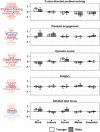The impact of social isolation and changes in work patterns on ongoing thought during the first COVID-19 lockdown in the United Kingdom
- PMID: 34599096
- PMCID: PMC8501798
- DOI: 10.1073/pnas.2102565118
The impact of social isolation and changes in work patterns on ongoing thought during the first COVID-19 lockdown in the United Kingdom
Abstract
The COVID-19 pandemic led to lockdowns in countries across the world, changing the lives of billions of people. The United Kingdom's first national lockdown, for example, restricted people's ability to socialize and work. The current study examined how changes to socializing and working during this lockdown impacted ongoing thought patterns in daily life. We compared the prevalence of thought patterns between two independent real-world, experience-sampling cohorts, collected before and during lockdown. In both samples, young (18 to 35 y) and older (55+ y) participants completed experience-sampling measures five times daily for 7 d. Dimension reduction was applied to these data to identify common "patterns of thought." Linear mixed modeling compared the prevalence of each thought pattern 1) before and during lockdown, 2) in different age groups, and 3) across different social and activity contexts. During lockdown, when people were alone, social thinking was reduced, but on the rare occasions when social interactions were possible, we observed a greater increase in social thinking than prelockdown. Furthermore, lockdown was associated with a reduction in future-directed problem solving, but this thought pattern was reinstated when individuals engaged in work. Therefore, our study suggests that the lockdown led to significant changes in ongoing thought patterns in daily life and that these changes were associated with changes to our daily routine that occurred during lockdown.
Keywords: COVID-19; experience sampling; isolation; lockdown; thoughts.
Conflict of interest statement
The authors declare no competing interest.
Figures



References
-
- Chiripanhura B., Carrera B., Monahan E., Furloughing of workers across UK business: 23 March 2020 to 5 April 2020. Office for National Statistics (2020). https://www.ons.gov.uk/employmentandlabourmarket/peopleinwork/employment.... Accessed 21 July 2020.
-
- Stephens M., Cross S., Luckwell G., Coronavirus and the impact on output in the UK economy: June 2020. Office for National Statistics (2020). https://www.ons.gov.uk/economy/grossdomesticproductgdp/articles/coronavi.... Accessed 21 July 2020.
-
- Campbell A., Caul S., Deaths involving COVID-19, England and Wales: Deaths occurring in May 2020. Office for National Statistics (2020). https://backup.ons.gov.uk/wp-content/uploads/sites/3/2020/06/Deaths-invo.... Accessed 17 June 2021.
-
- Banks J., Xu X., The mental health effects of the first two months of lockdown during the COVID-19 pandemic in the UK. Fisc. Stud. 41, 685–708 (2020).
Publication types
MeSH terms
Grants and funding
LinkOut - more resources
Full Text Sources
Medical

